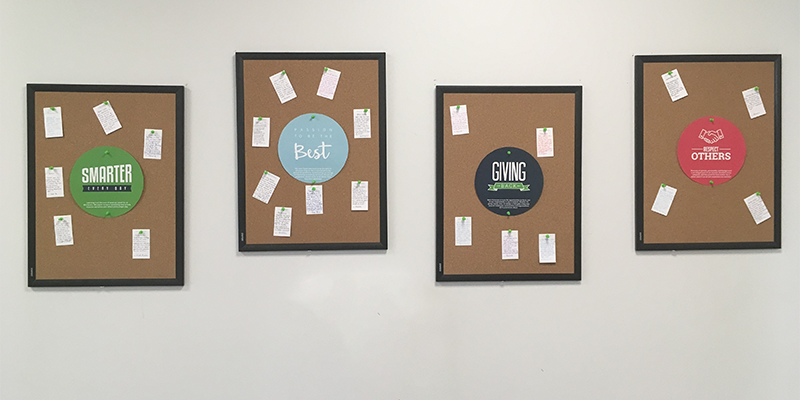All research points to the value of having a strong corporate culture. In the face of an employee turnover epidemic, organizations who can boast (and back up) strong organizational culture emerge victorious, with higher rates of employee retention and overall business success.
If culture is the cornerstone of your employee retention strategy, then living by your organizational values should be something your company strives for.
If you fall short of this goal and employees ignore your values, it could be a sign that it’s time to create strategies to prompt positive change in organizational culture.
We recognize that this is no easy task – at the end of the day, organizational culture tends to exist whether it’s purposeful or accidental. When you recognize a need for organizational culture change, you must also recognize that the culture you have now – the processes, the way employees communicate, and who they communicate with, all need to be changed in an intentional way.
So, how should organizations that realize the need for a changing work culture go about creating meaningful change?
- Identify the behaviors that reinforce your current culture and replace or add new ones that align with your desired values through consistent, positive support and reinforcement.
- Use behavioral addition to introduce new ways of working, and behavioral substitution to gradually phase out old behaviors leveraging visual aids and experiential modeling for smoother transitions.
- Culture really starts at the top. When leaders visibly embrace and model the behaviors you want to see supported by visual reminders like posters or memos, change spreads more organically across teams.
- Bring your values to life with tangible reminders such as policy books, emails, and manager conversations that reinforce desired behaviors and help everyone see culture as a lived experience, not just words.
The Relationship Between Workplace Values and Culture
When you begin changing your culture in an organization, the first place to start is your workplace values. Your values are the first clue employees have when it comes to how everyone should behave in the workplace. A value of "Commitment to Excellence" is a signal to employees that you value high-quality work, no matter how long it takes to achieve that outcome.
However, simply having and stating organizational values isn't enough - unless you reinforce the behaviors you want to see, your culture will become accidental, not intentional.
At BizLibrary, one of the ways our organizational values are reinforced is through our values wall. Here’s a sneak peek:

These boards act as a cultural symbol, to reinforce our commitment to our core values. All employees have access to recognition cards, which they can pin onto the boards to show how another employee is exhibiting one of our core values.
This might seem simple, but it's actively reinforcing desired behaviors and showing employees practical ways of living out these values in the workplace. Having core values and reinforcing them with several cultural symbols is the key to changing workplace culture.
Modifying Elements of Organizational Culture
Employees learn culture first through seeing, hearing, and experiencing it first hand. Once they've been exposed consistently, and have identified congruency between what is being shown, what is being said, and how they experience those factors, they'll begin to believe their experience. This is how organizational culture change becomes embedded.
Often, there are facets of your company's culture that may not be intentionally embedded - not every organizational behavior is purposeful. Additionally, not every intentionally embedded behavior is one that will help your company adapt and compete in your marketplace.
In order to change your culture, it is essential to identify all the behaviors that bolster the cultural status-quo. Focus then on the culture you want to create and build a list of behaviors you can easily modify through consistent and positive reinforcement.
Behavioral Addition and Substitution
Modification of culture comes in a few ways, namely behavioral addition and behavioral substitution.
Behavioral addition is when you introduce new models of behavior centralized around the cultural elements you're trying to achieve. These are the new additions you're encouraging your employees to do and display.
Behavioral substitution refers to replacing old behaviors with new ones through visual aides and experiential modeling.
Using Hiring to Support Your Changing Corporate Culture
If we know the kind of culture we want our organization to have, we can support our efforts by also hiring for culture.
Look to your prospective employees and new hires to have attitudes, beliefs, and behaviors that are consistent with the organizational culture you want to develop. Hiring for the culture you want breathes energy and momentum into the new direction of your changing organizational culture.
Deal with Complacent or Apathetic Attitudes
The longer an organization has had a certain type of culture, the more difficult it will be to change certain attitudes and behaviors of it.
You can get past employees’ pushback by gaining leadership buy-in for training - once employees see and experience their managers and peers modelling the behaviors that are also being encouraged with visual aids (posters, emails and memos, new policy books), you will start to see the culture of your organization transform.
Your leaders have massive influence over the direction of your company, so getting them on board with organizational culture change first will really help you make headway with employees.
Recap:
- Figure out how you can make your organizational values tangible and publicly reinforce behaviors that align with them
- Focus on the parts of your culture that you want to change and make a list of behaviors you can modify
- Identify if you're adding a new behavior or substituting an old one
- Encourage behavior changes through visual and other experiential aides (i.e. training, posters, emails, memos, policy books, verbal cues, 1-on-1 meetings with managers)
- Look at your prospective new hires for their potential to bring energy and momentum to the cultural goals you're looking to achieve
- Gain leadership buy-in and encourage modelling of desired behaviors to increase adoption of culture changes
